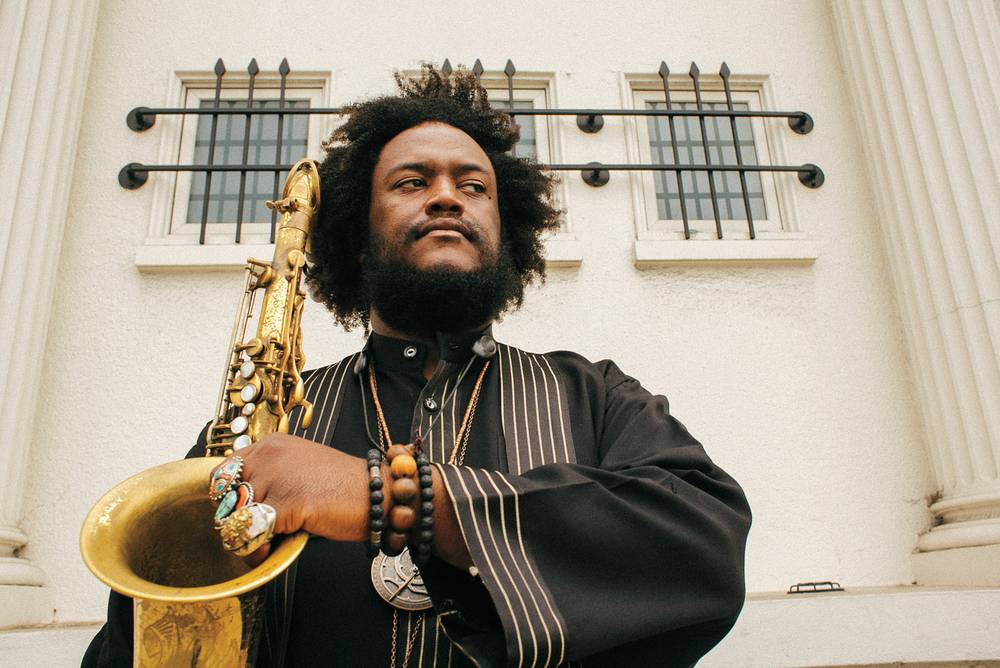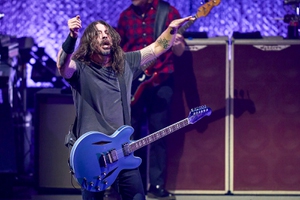It’s not every day that a jazz artist is the force behind one of the most talked-about albums of the year. And it’s even more unlikely that the same jazz artist would include our city in his tour itinerary. But even the most attention-deficient music fan would have a hard time ignoring the ambition and compositional excellence of tenor saxophonist Kamasi Washington’s The Epic, released earlier this year by Brainfeeder, the label owned by experimental electronic/jazz producer/DJ Flying Lotus. As if that wasn’t enough of a coup, Washington also served as saxophonist and string-section conductor on rapper Kendrick Lamar’s also-acclaimed To Pimp a Butterfly.
While he’s not bringing his current show highlighting The Epic to Las Vegas, Washington’s on-the-fly collaboration with the Lula Washington’s Dance Theatre will happen at our own Smith Center and nowhere else. Washington spoke about what we can expect at that performance, and how he musically came of age, during a recent phone call.
You’re appearing with your aunt Lula Washington’s Dance Theatre at the Smith Center. Is this new work you’ll be doing with her and her crew? I’ve played with her my all life. But her company has never danced to my music before. We’ll do a couple of songs as a band. We’re putting something together that’s pretty special. And it’s a cool venue.
People always look at jazz or instrumental music as being [inaccessible] but I think it’ll be cool. I love interacting, and [for this show], we’ll be improvising with the dancers and they are improvising with the band, and we’re improvising off each other. It’s a different experience improvising with someone moving to what you’re doing than [just] playing. It adds an extra dimension to the creative process.
When you were a student at UCLA, were you also playing gigs around town and applying what you were learning at school to your performances? I was touring with Snoop [Dogg] then! I was like, yo, this is crazy. I was missing two to three weeks out of every quarter; once I missed five weeks. This was before everyone had laptops. I remember having a paper due and I was in a hotel that didn’t have one of those business centers. This one hotel … had a TV and a Nintendo 64 controller. To send the e-mail I had to use the controller and the letters on the screen—click click A, click click T—which is how I had to write the whole three-page paper. I told the professor how I wrote it, and she gave an automatic A!
While at UCLA, you were mentored by trumpeter Gerald Wilson, whose orchestra you eventually joined. Did that influence the expansiveness of the sound we hear on The Epic? Absolutely. It influenced it indirectly and directly. So often in big bands the band is completely [committed] to the arrangement, but his felt more like a combo. The solos and what was gonna happen was up in the air.
And the band part of my record, that came spontaneously. We had a gig in Moorpark and I called [bassist/vocalist] Thundercat and [other musicians] to play with me and they all cancelled the day of show! I called [three other musicians], we’d all played together our whole lives, and they all showed up to gig ... it was magical. So I made a live recording of that day, and I was at Gerald’s house working on music for his album—I think it was Detroit—and I let him hear the recording. Brandon Coleman was playing keyboard strings, and Gerald was like, where are strings coming from?! I had a composition emphasis [at UCLA], and Gerald taught writing for orchestration, and he had said, you should write orchestra parts for this band. That stuck with me.
The song that resonates with me the most on The Epic might be “Malcolm’s Theme.” Was there anything specific about Malcolm that inspired you to craft an entire song about him? Yeah. I’m from South Central LA. My parents were great, college-educated, supportive, but there was pressure for an African-American boy to go down a certain path. There’s an image impressed upon us, and we find ourselves going down the wrong road. What brought me out of that was a cousin who gave me an Art Blakey/Lee Morgan mixtape. That got me into music. At same time ... these guys came to school and taught kids about our history and first thing they did was give me The Autobiography of Malcolm X. That was really powerful revelation for me. I could understand people who devoted their lives to the advancement of African Americans, and how I was headed toward the destruction of my community. It was an impossibility for me to think about violence and thugs now with these images that I had developed of myself [and] after reading that book and those words. With “Malcolm’s Theme,” it’s like if I could share that revelation with someone. And it’s also so pertinent right now to [the racial unrest] going on the world.
You were signed by Flying Lotus’ label, Brainfeeder, which also is home to Thundercat. Are the deep roots of the Brainfeeder artists the reason why you guys collaborate with each other so much and so easily? The Brainfeeder scene is a part of a larger scene going on in LA for years, all those guys from Gaslamp Killer to Miguel Atwood-Ferguson, definitely Thundercat—I grew up with him, he was an infant when I met him! (laughs)—so the roots go deeper than even before Brainfeeder. When Lotus came into his own, we’d bring him along with the other artists that had been making cool music. And the fusion of the live musicians were doing what Lotus and Gaslamp were doing. It was kind of natural, we’d already been collaborating.
Funny part is, we had Thundercat and his brother Ronald Bruner Jr. and Cameron Graves in Young Jazz Giants, the first band we had. The first gig we had was the [1999] John Coltrane Music Competition, and we won it. Thundercat was 12, I was 14 or 15, so was Cameron. So Ravi Coltrane gave the award to us and he had Steve Ellison [Flying Lotus] with him! We didn’t get to know each other then, but he was there for that first gig we had.
You mentioned working with Snoop Dogg, and you collaborated with Kendrick Lamar on his recent To Pimp a Butterfly album. Despite growing up in a jazz household, how much did hip-hop pay a part of your childhood, especially growing up in south LA? Before my cousin gave me that tape, I was more into hip-hop than jazz. It’s always been a part of the culture I’m from. It’s always been there. Musically, I didn’t start diving deeply into hip-hop until I got the Snoop gig. I listened to hip-hop recreationally. I wasn’t studying it. I was 18-19. It was in me and I knew all the songs, know what I mean?
So it was more of a revelation for me when I started playing it with Snoop. [His band] had a super-detailed way on how you should play something. It wasn’t particularly difficult music—they were just particular. The way the groove was played, the frequency and tones. The swells would go a certain way. Where you played within the beat was very detailed … the bass playing this part of the beat and the drummer playing that part of the beat. It was very complicated way of playing music … like using it an electron microscope [to see how] the parts make the music the way it is.
Jazz is so big and wide, you can get lost in it. When I started playing with Snoop and that detailed way of playing music, a whole new world opened up to me. When I was playing jazz—not just hip-hop, but all kinds of music—every opportunity I got to play, I used [that technique to recreate] this whole new world… like every style was a world and every musician was a country in that world.
Lula Washington Dance Theatre with Kamasi Washington and Marcus L. Miller September 16, 7:30 p.m., $19-$85. Smith Center’s Reynolds Hall, 702-749-2000.








